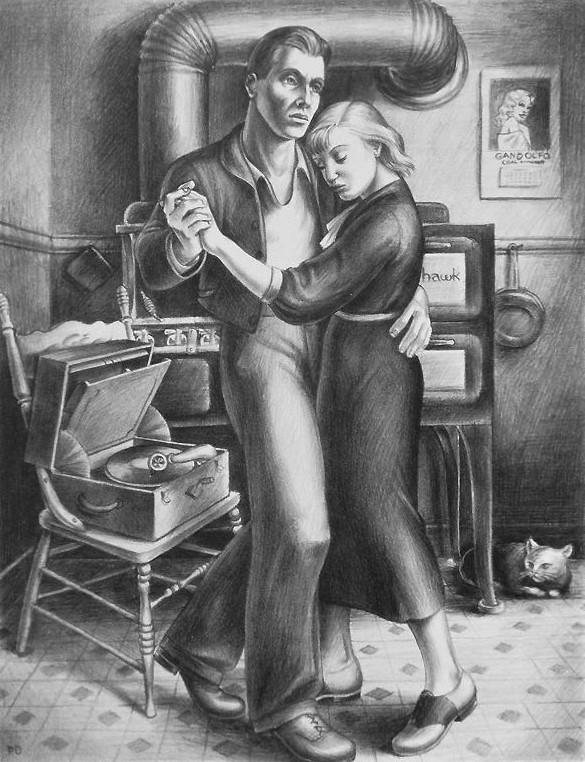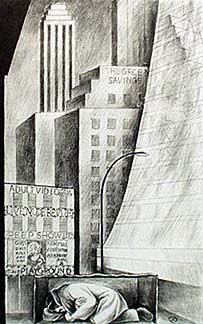Pele deLappe: RIP
Life long social realist painter, printmaker and activist, Pele deLappe (pronounced: “Peelee Dahlap”), died from a stroke on Monday, October 1st, 2007, at the age of 91.
Ms. deLappe’s art captured the life and times of her native San Francisco during the depression years and beyond, but the universal themes addressed in her artworks also gave them an eternal quality. She remained active and productive as an artist until the very end.

Already sketching the people of her city as a precocious 14 year old, deLappe met Frida Kahlo and Diego Rivera when the famed Mexican artists visited San Francisco in 1930. Rivera had been commissioned to paint murals for the San Francisco Stock Exchange and the California School of Fine Art (now the San Francisco Art Institute).
Undoubtedly inspired by the couple and the experience of making drawings with Kahlo, deLappe traveled to New York to attend art school. When she returned to San Francisco in 1934 at the age of 18, she joined the Communist Party USA (CPUSA).
Pele threw herself into the San Francisco maritime strike of 1934, contributing drawings and cartoons to the newspapers of striking workers, getting arrested twice while supporting the work stoppage, and making a series of portrait paintings depicting rank-and-file union members.
By the 1940s she became a graphic artist for the West Coast People’s World—a publication closely affiliated with the CPUSA, as well as creating artworks for the Daily Worker, the official “central organ” of the CPUSA. Pele also created graphics for The New Masses and the San Francisco Chronicle. It would be the beginning of a lifelong commitment to creating sociopolitical works of art.

Ms. deLappe’s 1937 lithograph titled, Street Scene, is a stunning example of her genius as a printmaker and social commentator. The depression era image depicts a well-heeled woman as she haughtily walks by a legless beggar and a rather tough looking dwarf, who’s counting the handful of change he’s earned from selling newspapers on the street.
A nun can be seen in the background, totally indifferent to her abysmal surroundings. But it is deLappe’s composition and handling of the lithograph’s delicate tones and deep shadows that makes the print so hauntingly evocative.
If I’m not mistaken, Street Scene, was created at the art department of the California Labor School—an institution that in the 1940’s attracted leftwing artists like Pablo O’Higgins, Louise Gilbert, Giacomo Patri, and Victor Arnautoff. Faculty from the California Labor School founded the Graphic Arts Workshop in 1952, it was a studio that provided, and continues to offer, facilities and print presses to artists interested in traditional methods of printmaking, from lithography to serigraphy (silkscreen).

The California Labor School was forced to close in 1957 because of rising anti-Communism—but the Graphic Arts Workshop survived as an independent artist’s printmaking collective. In the late 50’s its artists were creating prints and posters in support of the growing civil rights movement, and in the 1960’s its members turned their skills towards opposing the war in Vietnam.
Another print that I believe deLappe created at the Graphic Arts Workshop is the 1998 lithograph, The Playground, New York City. Here the artist depicted a homeless man sleeping in a cardboard box in the shadow of multi-million dollar corporate office towers. A porn shop called “The Playground” can be seen in the background, its lurid signage advertising adult videos and peepshows.

Works by Ms. deLappe were included in Pressed in Time: American Prints 1905 -1950, an exhibit that ran at The Huntington Library in San Marino, California from Oct. 2007 to Jan. 2008. Featuring 163 etchings, lithographs, woodcuts and silkscreen prints from 82 artists like John Sloan, George Bellows, and Edward Hopper, the show focused on the period when American artists expressed idealism and social activism in their art. The Huntington published a catalog book of the exhibit.
As fate would have it, Ms. deLappe was interviewed by the Huntington just weeks before her stroke and the opening of Pressed in Time. Her narrative was included in the show along with her featured works. A detailed obituary for Ms. deLappe appears on the San Francisco Chronicle website.

UPDATE: Pintmaker and current member of the Graphic Arts Workshop, Anthony Ryan, wrote to inform me that Ms. deLappe’s 1937 lithograph titled Street Scene, was created while she was attending classes at the Art Students League of New York and not at the Graphic Arts Workshop. A must read article about Pele deLappe appeared in the 2002 edition of MetroActive. The insightful piece, published when deLappe was 86, was in part an interview with the artist.
When asked how she found the sense of urgency to respond to current events, deLappe replied: “I don’t have a choice. I’m still alive and still part of society and still an artist. I can’t stop functioning in relation to other people, and… I refuse to take it lying down.” In 1999, Ms. deLappe published her autobiography, Pele: A Passionate Journey through Art and the Red Press.


